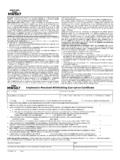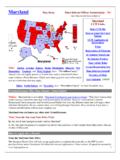Transcription of HISTORY OF MARYLAND WEATHER PART ONE …
1 HISTORY OF MARYLAND WEATHER including Chesapeake BaybyJames DawsonNote: This article is in two parts. part One is in narrative form with the high points of various WEATHER phenomena grouped by type. part Two, which follows, is a much more detailed chronological ONEMARYLAND S WEATHER (If You Don t Like It, Just Wait a Minute)by James DawsonEverybody talks about the WEATHER , so let s talk about our WEATHER . Here in Mary-land, midway between the equator and the North Pole, we get a Whitman s sampler of al-most every kind of WEATHER there is: heat, cold, drought, flood. But we shouldn t complain, WEATHER wise (and otherwise) we ve had it pretty lucky here. The extremes seldom last very long, nor are they as bad as in other parts of the country. Our climate is changeable though and it has been said that if you don t like Eastern Shore WEATHER , just wait a minute and we ll get something 1671, John Ogilby wrote in his New Description of Mary-Land: The Climate is very healthful, and agreeable with English Summer, the heats are equal to those of Spain, but qualifi d daily about Noon, at that time of the Year, either with some gentle Breezes, or small Showres of Rain: In Winter there is Frost and Snow, and sometimes it is extremely cold, insomuch, that the Rivers and the Northerly part of the Bay of Chesapeach are Frozen, but it seldom lasts long.
2 And some Winters are so warm, that People have gone in half Shirts and Drawers only at Christmas: But in the Spring and Autumn, (viz) in March, April, and May, September, Oc-tober and November, there is generally most pleasant temperate WEATHER : The Winds there are variable, from the South comes Heat, Gusts, and Thunder; from the North or North-West, cold WEATHER ; and in Winter, Frost and Snow; from the East and South-East, Rain. We ve had mild WEATHER around Christmas, too. And if we didn t dress in half Shirts and Drawers, we have worn Short-Sleeve Shirts and for contrast, Henry Callister writing from Oxford in 1741, painted a somewhat less idealized, but just as accurate, view of things, we are swarming with Bugs, Musketoes, worms of every sort both Land & water, Spiders, Snakes, hornets, wasps, Sea nettles, Ticks, Gnats, Thunder & Lightening, excessive heat, excessive Cold irregularities in abundance.
3 We can have all that, too. The recipe for MARYLAND WEATHER is a temperate stew sprinkled with occasional hot spices and ice follows are highlights of some of our meteorological irregularities. Remember that unusually high tide, or particular snow storm, or the time it rained frogs, but aren t sure of the date? Hopefully you can find it here. Hurricanes and Major Storms: we ve had a few bad ones over the centuries, but there are many more years when we haven t had any. The first one recorded was off Ro-anoke, Va. in 1586 which certainly hit MARYLAND also. It was notable in that it produced hail 1the size of hen s eggs. The first bad storm with damage specific to MARYLAND was noted by Henry Norwood in Jan. 1649 which cut many inlets through along the coast including probably the one at Fenwick, Del. Long before hurricanes were given people s names, we had the Dreadful Hurry Cane of 1667, which flattened an enormous number of trees and houses both in Md.
4 And Va., the Great Gust of 1724, the Great Rain and Horrible Gale of 1727, and the Great Gale of 1729. The storm of Oct. 1743 was tracked up the coast by Ben Franklin who showed how storms move. In Oct. 1749, a huge offshore hurricane flooded the Bay. A hur-ricane in 1769 caused much damage to Bay areas as did the Independence Hurricane of 1775 and the storm of Sept. 1785 which was called the most tremendous gale known in that century. And proceeding on into the 19th century: in 1812, a violent storm off the coast was thought to have prevented a British attack on Worcester Co. On Sept. 3, 1821, a hurricane passed directly over Norfolk, Va. causing much damage to the lower Bay areas as did the dreadful storm of June 1825 which is thought to have created Fishing Bay in Dorchester Co. The Great Hurricane of 1846 caused much destruction and a wind drove water into the Bay causing much flooding. On Aug. 24-25, 1851 the Appalachicola Storm hit the up-per Bay while the Expedition Hurricane of 1861 struck the lower Bay causing havoc there.
5 Storms play no favorites. Oops, almost forgot the Horrible Gale of 54 which was very de-structive. The hurricane of Sept 28-29, 1874, which hit the mouth of the Bay, was the first hurricane ever shown on a WEATHER map. The Centennial Storm of Sept. 1876 had such high winds and rain, tides were feet above normal in some areas. Sharps Island was cut in two and many vessels were lost in the Bay. Then came The Gale of 78, followed by the Sea Islands Hurricane of Aug. 1893 which pounded and drowned the lower Bay. Our coast has always been into the 20th century: the Sept. 1903 hurricane was said to have been the worst to hit Ocean City in 40 years and at Old Point Comfort, Va. hundreds of dead birds, stripped of their feathers, fell from the sky. On Aug. 4, 1915, a bad tropical storm hit Mary-land causing widespread damage. Trees and crops damaged in Talbot Co. Then in Feb. 1920, a terrific coastal storm battered Ocean City, tides were feet above normal and an inlet was cut through at Assateague.
6 The hurricane of Aug. 23, 1933 cut the inlet through at Ocean City and effectively opened it up for tourism. This was likely the most profitable storm damage in state HISTORY , but it also left 13 dead. On Deal s Island, it was said that cof-fins floated out of their graves. In 1954, MARYLAND was hit by three hurricanes in one year: Carol, Edna and Hazel. These were the days when hurricanes were only given women s names. Hazel was one of the few hurricanes to plow its way inland almost parallel to the Bay. With winds of over 100 it was one of our most intense storms and caused mil-lions of dollars in damage in the county (and that s in 1954 dollars). On Hooper s Island, many houses were damaged or destroyed and it was said that coffins floated out of their graves 1960 came Donna, but on March 6-7, 1962 the Storm of the Century was proba-bly the most destructive ever to hit our coast, devastating Ocean City and cutting two inlets through at Assateague.
7 SEA SWEEPS OVER OCEAN CITY; RESIDENTS FLEE; DAMAGE HIGH. Homes Float Away; Chincoteague Isle Homes Break Up. [The Eve-ning Sun, Baltimore, March 7, 1962]. At least three illustrated booklets were published about the disaster. The one by the Eastern Shore Times Press in Berlin, Md. was titled The Tides of March. In 1972, Agnes dealt the Bay such a blow that the submerged aquatic grasses have never recovered. And then into more socially enlightened times when hurri-canes were named for men and women we had Bob in 1985, Gloria in 1985 and in 1992 Danielle made landfall at the mouth of the the Super Storm came on March 13, 1993, it was an extremely powerful storm like no other and barometric pressures plunged to the lowest ever recorded for the 2 Bay: in Baltimore and at the mouth. Thunder snow was observed in Talbot Co. That is a rare phenomenon when it thunders and snows at the same time (it probably needs a special name, I propose either a snunderstorm or a thizzard.)
8 On Sept. 16, 1999, Hurricane Floyd nearly swamped us with excessive rain and on Sept. 19, 2003, Hurricane Isabel caused flooding as bad or worse then the storm of WEATHER : In 1756 the Bay froze and certainly not for the first time. The winter of 1779-1780 was so cold that the Bay froze over down to the mouth of the Potomac and ice was so thick that carts and carriages crossed the Bay from Annapolis to Poplar Island. In 1784, Baltimore harbor was closed until March 19 due to ice. In Feb. 1805 Haddaway s ferry was trapped in the ice off Poplar Island and passengers walked to shore. 1816 was the year with no summer. Frost and ice were common and farmers wore overcoats and gloves during the July wheat harvest. In 1852, the Susquehanna River froze so hard that railroad tracks were laid across the ice at Havre de Grace and used for over a month. On Feb. 10, 1881, ice floes sheared Sharps Island lighthouse from its foundations and carried it 5 miles with the terrified keepers trapped inside.
9 They later made it safely to shore. In Feb. 1899, a severe cold wave hit the state. Temperatures ranged from -4 in Ocean City to -26 in Garrett Co. and ice was 10 inches thick in the Bay. The winter of 1918 was so cold that the battleship Ohio was used as an icebreaker to keep the Bay open for wartime ship-ping. The Bay also froze in 1936 and 1945. In 1972, Talbot Co. had its coldest June tem-perature on record when it was 47 on June 11. The winter of 1977 was so severe that ice pushed the Sharp s Island light that was replaced in 1882 from the vertical, oysters were tonged from holes cut in the ice and there were ice boat races in St. Michaels on the Miles River. The winter of 2003 was said to be the worst to ever hit the state. That said, there have been many more years when the Bay didn t freeze at were particularly vulnerable and many suffered ice damage in 1872, 1877, 1879, 1881, 1882, 1884, 1893, 1894, 1899, 1904, 1918, 1935, and coldest temperature ever recorded in MARYLAND was -40 in Oakland (Garrett Co.)
10 On Jan. 13, 1912 and the coldest temperature in Talbot Co. was probably -15 in Feb. Storms: Two notable ones: on Jan. 10-11, 1805, St. Michaels was hit by an ice storm that felled many trees. Roads were almost impassible either on foot or by horse-back. And who can forget the ice storm 189 years and one month later on Feb. 11, 1994 which moved across Southern MARYLAND to slam into the Eastern Shore like a runaway gla-cier. St. Michaels and all of Talbot Co. were hit particularly hard, roads were treacherous, many trees were downed, and power was out for a week or more in some places, a prob-lem no one had in 1805. Tornados: On Aug 22, 1888, a tornado slashed its way from to Kent Co. leaving 11 people dead in its path. On Nov. 9, 1926, MARYLAND s deadliest tornado hit the small town of La Plata in Charles Co. causing 17 deaths. A school house with 60 children in-side was carried 50 feet and some children were carried up to 500 feet away.




